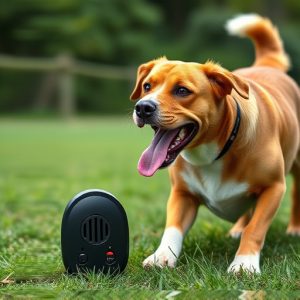LED Dog Repeller: Stationary vs Mobile – Which Deters Dogs Best?
This text presents a Stationary Vs Mobile Dog Repellent Comparison, emphasizing the unique pros and…….
This text presents a Stationary Vs Mobile Dog Repellent Comparison, emphasizing the unique pros and cons of each type.
Stationary repellents offer consistent, large-area protection with powerful LED lights, ideal for defining outdoor spaces like patios and gardens. However, they require upfront installation and may have limited range. Mobile repellents, on the other hand, are portable, flexible, and perfect for temporary use or dynamic landscapes. Some models incorporate LEDs for enhanced deterrence, making them suitable for various environments. The optimal choice depends on individual needs: stationary for targeted areas and mobile for adaptability and versatility, considering factors like range, weatherproofing, and battery life.
“Discover the ultimate solution to manage your outdoor spaces with an innovative electronic dog repeller featuring LED lights. This comprehensive guide explores the world of dog deterrents, shedding light on their types and effectiveness. We delve into the unique role of LED technology in scaring off unwanted canine visitors. Furthermore, our Stationary Vs Mobile Dog Repellent Comparison highlights the pros and cons of each, aiding you in making an informed decision. Learn what factors matter most when choosing a repeller for optimal results.”
- Understanding Dog Repellents: Types and Their Functionality
- The Role of LED Lights in Dog Deterrence
- Comparing Stationary and Mobile Devices: Pros and Cons
- Choosing the Right Repeller: Factors to Consider for Effective Use
Understanding Dog Repellents: Types and Their Functionality
Dog repellents are designed tools aimed at deterring canines from entering or lingering in specific areas, offering a humane and effective solution for managing dog interactions. These devices operate on various principles, with two primary types: stationary and mobile repellents. Stationary repellents, such as electronic fences or scent-based barriers, rely on physical boundaries and natural instincts to keep dogs away. They emit signals or odors that dogs find unpleasant, conditioning them to avoid certain areas. On the other hand, mobile dog repellents, like handheld devices or sprayers, use sound, scent, or light to create a temporary but effective barrier. These portable options are ideal for outdoor activities, public spaces, or situations where a quick response is needed to repel dogs without permanent installation.
When considering a stationary vs. mobile dog repellent comparison, understanding their functionality and limitations is key. Stationary repellents offer consistent protection over large areas but require upfront installation and may have limited range. They are suitable for defining and protecting outdoor territories. In contrast, mobile repellents provide flexibility and portability, making them convenient for temporary use or specific scenarios. This comparison highlights the diverse options available to meet different needs, ensuring dog owners can choose the most appropriate repellent for their situations.
The Role of LED Lights in Dog Deterrence
LED lights play a significant role in enhancing the effectiveness of dog repellers, especially when compared to traditional stationary models. In the battle against unwanted canine visitors, mobile devices equipped with LEDs offer a unique advantage. These lights serve as a powerful visual deterrent, as dogs tend to avoid areas bathed in bright light, mimicking natural behaviors where open spaces are illuminated.
When considering a stationary vs. mobile dog repellent comparison, LED technology gives the latter an edge. Mobile repellents can actively scan and cover larger areas, using light to create a virtual barrier. This dynamic approach differs from static devices that rely solely on scent or sound. The strategic use of LEDs allows for a more adaptable and effective solution, making them ideal for diverse environments, from backyards to public spaces.
Comparing Stationary and Mobile Devices: Pros and Cons
When it comes to protecting your space from unwanted canine visitors, choosing between a stationary and mobile dog repeller involves weighing the pros and cons of each type. Stationary devices are often more affordable and easier to install, making them ideal for those seeking a straightforward solution. They can be strategically placed in problem areas, emitting a consistent signal that discourages dogs from entering. However, their fixed location might limit flexibility, especially if you have a large yard or dynamic outdoor spaces.
On the other hand, mobile dog repellers offer greater versatility. These devices are portable and can be moved to different locations as needed. This feature is beneficial for those with varying weather conditions or changing landscapes. Moreover, some mobile repellents incorporate LED lights, providing an additional layer of protection by deterring dogs through both sound and visual cues. While they may carry a higher initial cost, their adaptability could save you money in the long run by eliminating the need for multiple stationary devices.
Choosing the Right Repeller: Factors to Consider for Effective Use
When choosing an electronic dog repeller with LED light, it’s crucial to consider several factors that will impact its effectiveness. One key distinction to make is between stationary and mobile options. Stationary repellers are ideal for confined areas like patios or gardens, offering consistent protection without the need for constant movement. They often feature powerful LED lights that can deter dogs from approaching after dark. On the other hand, mobile repellers provide flexibility, perfect for outdoor spaces with varying landscapes or for use during specific events.
Additionally, consider factors like range and sensitivity levels. A longer range ensures broader coverage, while adjustable sensitivity allows you to tailor the device’s response to different dog sizes and behaviors. Weatherproofing is another essential consideration, especially if you live in a region with harsh climates. Remember to check battery life and charging options for mobile repellers to ensure continuous use without interruption.
In conclusion, both stationary and mobile dog repellents have their unique advantages in the context of keeping unwanted canine visitors at bay. When deciding between them, consider your specific needs, outdoor layout, and budget. For larger areas or complex landscapes, a mobile repellent’s versatility and range might be preferable. Conversely, stationary models offer consistent protection for smaller, well-defined spaces. Understanding the functionality of each type, especially the added deterrent effect of LED lights, empowers pet owners to make an informed choice for an effective Stationary Vs Mobile Dog Repellent Comparison.


